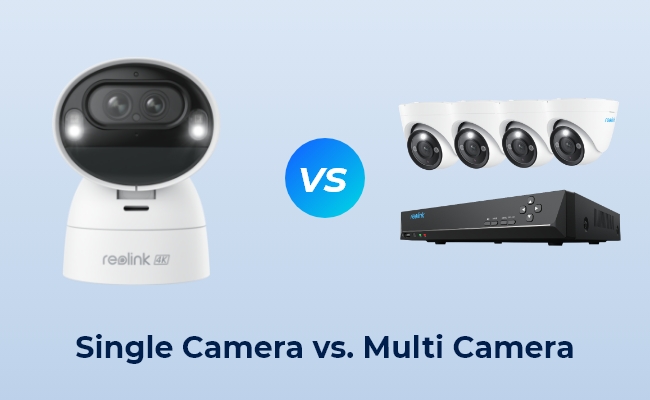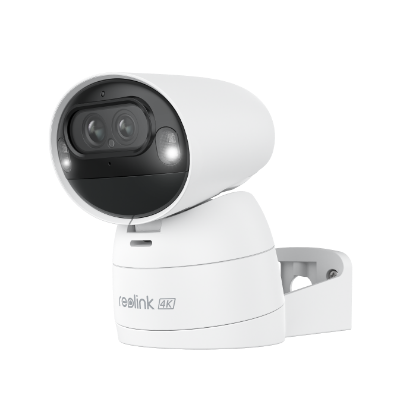Single Camera vs. Multi Camera: Which Is More Effective?

When it comes to security systems, the debate between multi cam vs single cam setups has been ongoing for quite some time.
Both options offer unique advantages and cater to different requirements, making it crucial to understand their key differences before deciding which one suits your needs best. In this comprehensive guide, we'll explore the intricacies of single camera vs multi camera systems, discussing their pros, cons, and various applications.
Basics of Single and Multi Camera
Before we dive into the nitty-gritty, let's establish a clear understanding of what single-camera and multi-camera systems entail.
What does Single Camera Mean?
A single-camera system, as the name implies, employs a solitary camera for surveillance or monitoring purposes. This setup is typically more affordable and straightforward, making it an attractive choice for those with limited budgets or modest coverage requirements.
What does Multi Camera Mean?
In contrast, a multi-camera system utilizes multiple cameras strategically placed throughout a designated area. This approach offers more comprehensive coverage, enabling users to monitor multiple angles and locations simultaneously. Multi-camera systems are often preferred for larger properties, businesses, or events that demand extensive surveillance.
Multi Camera vs Single Camera: Key Differences
While both single and multi-camera systems serve the common purpose of monitoring and surveillance, they differ in several key aspects.
Coverage
One of the most significant differences between single camera and multi camera lies in the coverage area. A single camera system is limited to capturing footage within its field of view, which can be restrictive for larger spaces or multi-angle monitoring. Conversely, a multi-camera setup offers broader coverage, allowing for simultaneous monitoring of multiple areas from various vantage points.
Surveillance Capability
The surveillance capability of a multi-camera system is significantly higher than that of a single camera. With multiple cameras, blind spots are minimized, and the chances of capturing critical events or activities increase substantially. This advantage makes multi-camera systems a preferred choice for applications that demand comprehensive surveillance, such as large commercial properties or public spaces.
Flexibility
Multi-camera systems offer greater flexibility in terms of coverage and monitoring. With the ability to position cameras at strategic locations, users can tailor the system to their specific needs, ensuring optimal coverage of high-risk areas or blind spots. Additionally, multi-camera setups often come with advanced features like pan, tilt, and zoom capabilities, further enhancing their versatility.
Cost
While the initial investment for a multi-camera system is typically higher due to the need for multiple cameras and supporting infrastructure, the long-term cost-effectiveness can vary depending on the application and coverage requirements. Single-camera systems are generally more affordable upfront but may require additional cameras or upgrades to meet evolving monitoring needs.
Single Cam vs. Multi Cam: Pros & Cons
To help you weigh your options, here's a comparison table outlining the advantages and disadvantages of single-camera and multi-camera systems:
Single vs Multi Camera: Use Cases
The choice between a single-camera and a multi-camera system often depends on the specific use case and requirements. Here are some common applications for each:
Single Cam Applications
- Entry points: Single camera systems are suitable for monitoring entry points such as front doors or gates, providing a focused view of these critical areas.
- Baby and pet monitoring: With a single camera, you can keep an eye on your baby's or pet's activities within a specific room or area.
- Traffic monitoring: Single cameras can be used for monitoring traffic flow at intersections or specific locations on roads.
- Home security: A single camera system can provide basic home security by monitoring the main entrance or other critical areas of your home.
Multi Camera System Applications
- Large property monitoring: Multi-camera systems are ideal for monitoring large properties like commercial buildings or warehouses, providing comprehensive coverage of multiple areas simultaneously.
- Business surveillance: Businesses often require multi-camera setups to monitor different sections of their premises, such as retail stores or office spaces, ensuring complete surveillance.
- Event monitoring: Multi-camera systems are essential for monitoring large-scale events like concerts or conferences, capturing activities from various angles and locations to ensure comprehensive coverage.
Best Single Camera with Multi Lenses Recommendation
While traditional single-camera systems have their limitations, some manufacturers have begun integrating multiple lenses into a single device, offering a unique blend of comprehensive coverage and ease of installation. One such innovation is the Reolink Argus Track, a dual-lens Wi-Fi solar/battery camera with auto-zoom tracking capabilities.
The Argus Track boasts an impressive 4K 8MP Ultra HD resolution, ensuring crisp and detailed footage. Its dual-lens design allows for pan, tilt, and 6X hybrid zoom functionality, providing versatile monitoring capabilities. Additionally, the camera features color night vision and supports both 5GHz and 2.4GHz dual-band Wi-Fi for reliable connectivity.
4K Dual-Lens Wi-Fi Solar/Battery Camera
4K 8MP Ultra HD, Auto-Zoom Tracking, Pan, Tilt & 6X Hybrid Zoom, Color Night Vision, Dual-Band Wi-Fi.
Multi Camera vs Single Camera Sitcom: What's the Difference?
While we've explored the differences between multi camera sitcom vs single camera systems in the context of surveillance and security, these terms also hold significance in the world of television and filmmaking.
In the realm of sitcoms (situational comedies), the distinction between multi camera sitcom vs single-camera productions is primarily related to the shooting style and aesthetic.
Multi-camera sitcoms, such as "Friends" and "The Big Bang Theory," are typically shot in front of a live studio audience using multiple cameras simultaneously capturing the action from various angles. This approach allows for a more theatrical feel and enables the preservation of the audience's laughter and reactions.
On the other hand, single-camera sitcoms, like "The Office" and "Modern Family," employ a more cinematic shooting style with a single camera capturing each scene from different angles and perspectives. This technique often lends itself to a more immersive and naturalistic viewing experience, as well as greater flexibility in terms of shooting locations and camera movements.
While the choice between multi-camera and single-camera sitcoms is primarily a creative decision, it can significantly impact the overall tone, pacing, and visual aesthetic of the final product.
FAQs
What are the disadvantages of multi-camera?
While multi-camera systems offer comprehensive coverage and enhanced surveillance capabilities, they also come with some drawbacks. These include higher upfront costs, more complex installation and maintenance requirements, and the potential for increased energy consumption due to multiple cameras operating simultaneously.
Is Friends single or multi-camera?
"Friends" is a classic example of a multi-camera sitcom. It was shot in front of a live studio audience using multiple cameras to capture the action from various angles simultaneously.
What are the benefits of a single camera?
Some of the main benefits of a single-camera system include lower upfront costs, simpler installation and maintenance, and a more straightforward setup. Additionally, single-camera systems can be suitable for applications that require focused monitoring of a specific area or entry point.
Conclusion
In the ongoing debate of single-camera vs. multi-camera systems, there is no one-size-fits-all solution. The choice ultimately depends on your specific requirements, budget, and the level of coverage needed. While single-camera systems offer an affordable and streamlined option for basic monitoring, multi-camera setups provide comprehensive surveillance and greater flexibility, making them ideal for larger properties, businesses, or events.
We'd love to hear your thoughts on this topic. Have you had experience with single-camera or multi-camera systems? Share your insights and perspectives in the comments below.
Search
Subscribe for the Latest Updates
Security insights & offers right into your inbox

